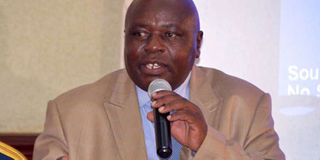Why the weatherman got it right this time

Kenya Meteorological Department Director Peter Ambenje. PHOTO | FILE | NATION MEDIA GROUP
What you need to know:
- The department’s director Peter Ambenje said the accuracy in their forecasts has been brought about by the organisation’s advancement in dissemination of information.
The department has also acquired advanced technology that it has been using lately to collect weather data and hence the accurate results.
- The agency has gone through many improvements in terms of consistent and continuous training of its staff.
Acquisition of advanced technology has helped the weatherman give precise predictions since the long rains began.
Before this, the Kenya Meteorological Department has for years been the butt of many jokes by Kenyans due its forecasts being largely inaccurate.
But of late the thumbs of disapproval have quickly turned into praise with the weatherman drawing an avalanche of admiration from the hitherto critical and sceptical Kenyans for getting the forecasts right.
ADVANCEMENT
Since the turn of the year, weather forecasts from the government department – which come in on a daily, five days, seven days, monthly and quarterly basis – have been so accurate that every forecast put out has precisely captured the weather pattern of the period under forecast.
The department’s director Peter Ambenje said the accuracy in their forecasts has been brought about by the organisation’s advancement in dissemination of information. He said they have also diversified their dissemination channels so that there are more people getting the forecasts in a timely manner.
“We have been improving with time and we have been validating our forecasts so most of them have been correct, 80 to 85 per cent. We have been making sure that we effectively disseminate the information to get to as many users as possible,” said Mr Ambenje.
COLLABORATION
The deputy director, Mr Samwel Mwangi, said the growth in social media has aided the dissemination of the forecasts as they are shared everywhere. “It could be accurate but if there is no social media exchange then it would not come out as an accurate forecast,” said Mr Mwangi.
There have been reports that the government agency has entered into a collaboration with the US National Weather Service to share weather forecasts, warnings and alerts, among other weather-related products.
But Mr Ambenje pointed out that all national meteorological services collaborate with one another under the umbrella body, World Meteorological Organisation (WMO), where they exchange data through the global communication system.
COMMUNICATION
“For us we collaborate with everybody in terms of data exchange and that has been the case from time immemorial. If you want to do a forecast for Kenya you do not rely on Kenyan data alone, you have to get data from different parts of the world also,” he said.
He explained that Kenya used to get weather data from South Africa even at the time Apartheid rule was still existent in the country through the global communication system.
Mr Mwangi also adds that through WMO, which Kenya joined in 1964, they have been able to share expertise and technology with the developed and developing countries. He said Kenya is also making advances in science and computing systems. “It forms a nice basis of learning from people better than you are and also for sharing solutions to problems you might have,” he said.
AUTOMATIC
The department has also acquired advanced technology that it has been using lately to collect weather data and hence the accurate results.
Mr Ambenje said the department has adopted automatic weather stations to complement the manual ones they have been using.
He explained that the automatic weather stations, which are the latest technology, work almost the same way as the manual ones. The only difference is that in the manual one observations are made every hour, but the automatic station gives information at whatever interval you decide.
“We are having a man-machine interface in terms of weather observation, but the standards have been the same. The information you get from automatic weather stations are the same you get from manual observations,” said the director.
IMPROVEMENTS
“We installed automatic weather stations in three airports like JKIA, Kisumu and Eldoret last year and others. We are also in the process of acquiring more technology in terms of data processing and archival,” he added.
Mr Mwangi also explained that the agency has gone through many improvements in terms of consistent and continuous training of its staff in various fields of forecasting, climate change and technological changes.
Mr Ambenje pointed out that most of the seasonal rainfall was expected during the peak month of April and May.





